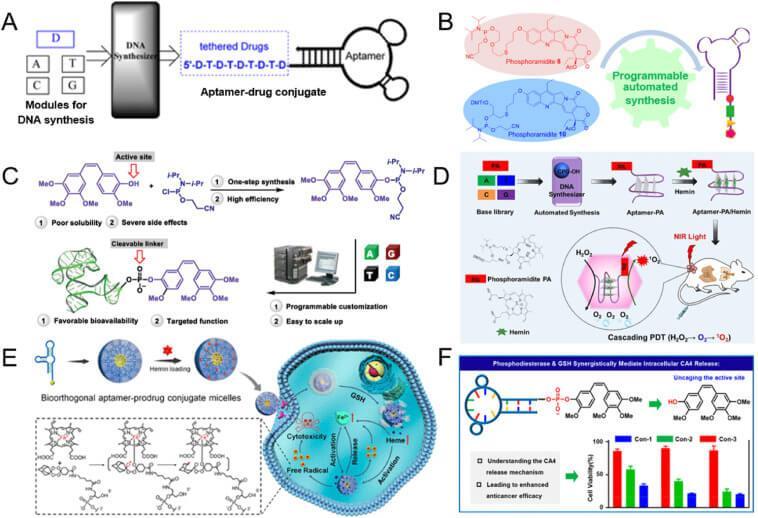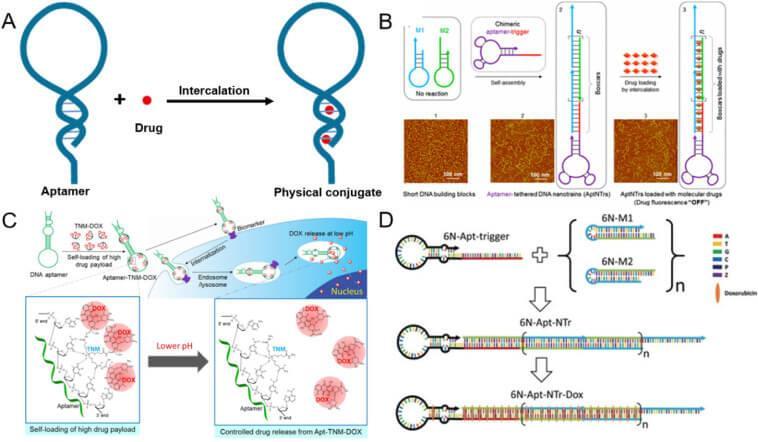
4 minute read
Small Molecule Drug Conjugated ApDC
The coupling of aptamers and small molecule drugs mainly adopts three forms: covalent conjugation, nucleic acid synthesis and physical interaction.
Covalent Conjugation
Advertisement
This form is similar to ADC. The first ApDC (A) through covalent coupling was developed in 2009, and then the circular bivalent ApDC (B) was developed, which can achieve specific recognition and effective internalization, and has higher stability than univalent ApDCs, and can achieve precise control of drug proportion.
The triptolide ApDC developed in Figure D shows high specificity and cytotoxicity to the MDA-MB-231 cell line. TNBC showed a good antitumor effect in vivo, with negligible side effects on healthy tissues.
In addition, maleimide -MMAE and -MMAF coupled with mercaptan modified APdcs have been developed, showing high toxicity and specificity to pancreatic cancer cells. Also, polypeptide-coupled camptothecin ApDC showed a very low IC50 (31.9nmol/L) and in vivo antitumor efficacy with a 20-30 fold reduction in the effective dose compared to previously reported.
Nucleic Acid Synthesis
Coupling various nucleoside drugs to aptamers via solid-phase synthesis or enzymatic method is an ingenious strategy for the preparation of targeted nucleoside drugs. The first photoactivated ApDC (A) developed through solid-phase synthesis was reported in 2014. In 2020, the same research team reported camptothecin (B), CA4 (C), Pyroleaves A (PA) (D), and artificial prodrug base (E) ApDC.
Among them, CA4 ApDC is more effective and safer than CA4 alone. PA APdcs also show high efficacy in targeted photodynamic therapy.
Nucleoside drugs are similar to bases and can be enzyme-coupled to form aptamers.
Enzymatic synthesis is the most effective way to obtain long chain APdcs, but only a few nucleoside drugs can be used for enzymatic coupling, thus limiting the variety of payloads. Therefore, successful enzymatic coupling of APdcs will ultimately depend on the development of more multifunctional enzymes
ApDC construction based on nucleic acid synthesis is an efficient and modular ApDC construction method.
Physical Conjugation
Doxorubicin (DOX) is an anticancer drug widely used clinically, which can interact with double-stranded DNA. In 2006, the first aptamer-DOX conjugated drug (A) was developed through non-covalent coupling. In addition, there are Aptamer-linked DNA nanochains (B), TNM-DOX constructed from three DOX molecules (C), and ApDC with artificial bases (D).
However, the safety and stability of this method in vivo is still a major challenge and needs further research.

Biomacromolecule-based ApDC

Aptamer-Protein Conjugate
Conjugation of aptamers to biomacromolecules such as proteins is one of the ways to increase the circulating half-life of aptamers.
A human serum albumin (HSA)-ApDC is currently developed, which exhibits high stability and high specificity. Conjugation of aptamer to antibody (B) can overcome the problem of short circulation time without affecting its affinity.
EGFR Aptamer-ErBB2 antibody conjugate and EGFR APtamer-PDL1 antibody conjugate (C) have also been developed. Egfr-pdl1 APdcs effectively activate T cells to kill tumor cells.
But at present, it is a big challenge to develop a specific coupling method between aptamers and proteins.
Aptamer-Nucleic Acid Conjugate
Aptamers can be coupled to nucleic acid drugs through complementary hybridization to deliver NA drugs to target cells. An aptamer-miRNA conjugate (A) has previously been developed to treat glioblastoma, which can effectively prevent the proliferation of glioblastoma. There is also photoactivated siRNA ApDC (B), which enters the cell and causes gene silencing when exposed to light.
There is also an AS1411 aptamer coupled with TAP (antigen-treatment-associated transporter) siRNA drug (C) that inhibits the growth of various tumors without significant toxicity.
In addition to siRNA and miRNA, Aptamers can be coupled with Aptamers to form polyvalent or functional APdcs that have been developed as LYTAC APdcs (D).

Coupling of nucleic acid drugs with aptamers can significantly improve the efficiency of nucleic acid drugs entering target cells or organs, but there are still some problems such as non-specific adsorption of proteins in serum caused by electronegativity of nucleic acid molecules.

Aptamer-Biotherapeutic Drug Conjugate
Biotherapeutic drugs, such as viruses, bacteria, and cells, can also be conjugated with aptamers.
Such as multivalent aptamer AAV conjugated drugs (A) for gene transfection, aptamer-macrophage conjugated drugs (B) for tumor therapy, and aptamer-bacterial conjugated drugs (C) for bacterial localization at tumor sites, studies have shown that aptamer conjugated attenuated salmonella showed strong antitumor function and a highly activated immune response.
Aptamer-Multidrug Conjugates (ApMDC)
The team of academician Tan Weihong and researcher Liu Jinyao of the Institute of Molecular Medicine, Shanghai Jiaotong University designed and prepared a new type of nucleic acid aptamer-multidrug conjugate, which is triggered to self-assemble into nanomicelle by the strong hydrophobicity of multiple drug molecules. The formation of nanoparticles inhibits the binding of nucleases to aptamers located in the micellar shell, thus significantly enhancing their resistance to nucleases. Meanwhile, hybrid micelles containing PEG- multidrug conjugate analogues were prepared by co-self-assembly technique. The introduction of PEG into the micellar shell can effectively resist the non-specific adsorption of plasma proteins, thus significantly prolonging the blood half-life of self-assembled micelles and further enhancing the enrichment of tumor lesions.

The antitumor efficacy of the optimized ApMDC nanomicelles was evaluated systematically in vitro and in vivo. The results of animal experiments showed that the micelles could enhance the immunogenic death of tumor cells, and thus significantly enhance the specific anti-tumor immune response of immune checkpoint blocking in tumor-bearing mice. ApMDC nanomicelles provide a common platform for structure-function optimization of drug couplings and nanomaterials, and an alternative for improving the antitumor effect of drugs.

Summary And Prospect
According to current studies, ApDC has potential high efficacy and advantages in cancer treatment, but few of them have entered clinical trials. Some factors limiting its application in vivo are low specificity in vivo and fast clearance rate of kidney.

Key strategies to overcome these problems include:
1. The introduction of unnatural nucleic acids enriches the diversity of aptamer library, and develops efficient nucleic acid amplification enzymes that can recognize unnatural nucleic acids;
2. Screen aptamers in complex environments, such as in vivo SELEX.

